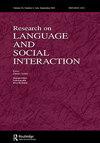处理澳大利亚触觉签名对话中的转弯转换
IF 2.1
1区 文学
Q1 COMMUNICATION
引用次数: 2
摘要
本文探讨了聋哑澳大利亚手语(Auslan)使用者如何通过包括触觉(手)和动能(身体运动)输入等多种方式进行交流,来管理转身转换。对聋哑人交流的研究通常采用基于信号的方法。相比之下,本文应用了更广泛的会话分析(CA)框架,该框架是基于主要依赖于听觉-声音和视觉资源的对话者开发的,但已有效地应用于一系列语言,参与者和环境。通过对单个案例研究的细粒度分析,本文考察了触觉澳大利亚手语如何在可能的完成点定位转向转换的相关性。这项研究阐明了有触觉的澳大利亚手语者如何进行转弯的机制,并促进了我们对CA分析潜力的理解,以及聋哑澳大利亚手语者在互动编排中协调序列、动作和多模态的方式。数据是触手可及的澳大利亚语。本文章由计算机程序翻译,如有差异,请以英文原文为准。
Handling Turn Transitions in Australian Tactile Signed Conversations
ABSTRACT This article explores how deafblind Australian Sign Language (Auslan) users, who communicate through an alternative range of modalities including tactile (hands) and kinetic (body movement) inputs, manage turn transitions. Studies of deafblind communication have typically employed a signal-based approach. In contrast, this article applies broader Conversational Analysis (CA) frameworks, which have been developed based on interlocutors who primarily rely on auditory-vocal and visual resources but have been productively applied to a range of languages, participants, and settings. Through fine-grained analyses of a single case study, this article examines how tactile Auslan signers orient to the relevance of turn transitions at possible completion points. The research illuminates the mechanics of how tactile Auslan signers negotiate turns and advances our understanding of both the analytical potentials of CA and the ways particular deafblind Auslan signers coordinate sequences, actions, and multimodalities in their interactional choreography. Data are in tactile Auslan.
求助全文
通过发布文献求助,成功后即可免费获取论文全文。
去求助
来源期刊
CiteScore
7.30
自引率
7.40%
发文量
20
期刊介绍:
The journal publishes the highest quality empirical and theoretical research bearing on language as it is used in interaction. Researchers in communication, discourse analysis, conversation analysis, linguistic anthropology and ethnography are likely to be the most active contributors, but we welcome submission of articles from the broad range of interaction researchers. Published papers will normally involve the close analysis of naturally-occurring interaction. The journal is also open to theoretical essays, and to quantitative studies where these are tied closely to the results of naturalistic observation.

 求助内容:
求助内容: 应助结果提醒方式:
应助结果提醒方式:


